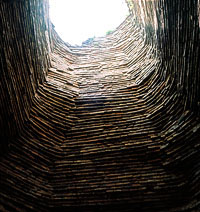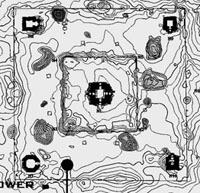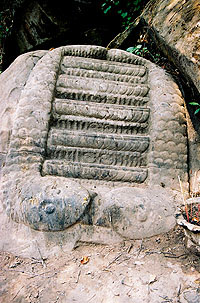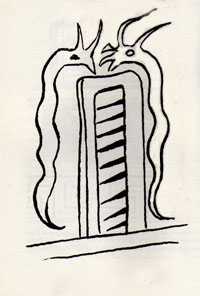

Looking directly upward and through the opening at N7 one can imagine a pillar of light holding up the heavens. It is also an eye looking into the heavenly realms. When the deity with an equine head was placed on the circular pedestal within this eight sided temple it symbolized Vishnu's saving the universe. It's even conceivable that this equine deity (Hayagriva) was holding the four Vedas in his hands (now missing) but we do know Vishnu was standing under a circular opening on a circular pedestal in an octagonal temple. These are enough symbolic clues to safely assign the most sacred message as represented in the Vastupurusamandala.
If we look at where the N7 tower is located we can see that it is part of a larger Vastupurusamandala. The topographical ground plan for the northern group of temples (fig. 17.) shows that temple N1 is in the center, N7 is in the SW corner, N6 is in the NE corner, and N9 is in the SE corner. Clearly this follows the Vastupurusamandala design.

According to Kramrisch (1976:73) the Vastapurusa is cosmogonically the story of the first appearance of existence. It is a descent, or falling off, from the Supreme Principle and a coming to earth. Temple N1 in the center symbolizes Brahma and in the SW corner is N7 which is assigned to represent a specific star name. The placement of all the temples at Sambor Prei Kuk formed an enormous Vastapurusamandala acting as a cosmogonic (creation of the universe) template whereby all the temples had astronomical significance.
A few inscriptions indicate the presence of cults during this reign at Sambor. One of the inscriptions of Sambor indicates a cult of the Vedic sage Jaimini and a sanctuary belonging to the same group provides inscriptions that the presiding priest of the temple must be a Pasupati (name of Rudra) Brahman or a type of Brahman (Briggs 1951: 510). The Jaimini system is the most exalted of the Vedic astrological systems, and when we see the mention of Pasupati mentioned we can safely assume it is in reference to the time when Rudra shot his arrow at Prajapati, the time when Orion shifted to Rohini - a transition that occurred after 4000 BCE (Kak et al. 1995: 236). The yoga star to be identified with Prajapati-Manu is Rohini the red cow of plenty, favorite wife of the moon- our star Aldebaran. It coincided with the equinoctial point in about 3200 BCE (Worthen 1991: 223). This example shows how an equinox marker and pole star no longer functioned the same way and was the reason the sages created their stories of the heavens which have erroneously been identified as myths but are in fact the stories of the movement of the heavens.
From making these astronomical associations at Sambor Prei Kuk we can only surmise other astronomical influences which were brought down from the newly formed capital center at New Kuruksetra by King Mahendravarman as he began designing his new Temple of the Lord thus lending to the belief that New Kuruksetra was the celestial archetype for all future kings. It's safe to say that New Kuruksetra remained the cosmic center for the kings through the duration of the Khmer empire as pointed out by Briggs who shows that gifts were repeatedly made to Vat Phu by the royal families (Briggs 1951). What all this shows is the contents of the Vedas, including the story of the Mahabharata, became the spiritual template by which the Khmer kings built their empire. But these kings also developed their own style based on their own understanding but still incorporating the Hindu gods. They left behind a uniquely encoded story of the creation of the universe with their stone monuments surrounding the holy land of New Kuruksetra as well as all of Southeast Asia.
Conclusion:
In concluding this paper, as due to space, I have had to leave out an untold number of details of the names of constellations which are mentioned in the Mahabharata. (Achar 2004) and Balakrisna (1998) are two excellent resources for ancient Indian star names. The cosmic center at New Kuruksetra is represented by the alignment of the sunrise during winter solstice. Beginning in 1998 and lasting until 2022 the winter solstice sun rises closer and closer to another cosmic center that being the center of our local galaxy. This solar alignment with the galactic center takes place every 26,000 years and had the deepest spiritual meaning for the Vedic sages. The center was called "Vishnunaabhi' the eye of Brahma (Jenkins 2002: 129).
The knowledge of this celestial event was the reason the Khmer kings had created so many rituals and sacrifices to the gods. The axial causeway at Vat Phu was a stairway to heaven. We can, therefore, assume that many rituals and sacrifices to the gods were conducted there. There are stories of human sacrifices on the top of Lingaparvata and even the two quadrangle palaces were considered to hold religious ceremonies. Lying against the cliff, just north of the main shrine, is a symbolic carving that has received as little attention as the equine deities. It is a small stairway guarded by two serpents (fig. 18a.) which can be none other than guardians to the portal of heaven.


If we look at other symbolic carvings at Vat Phu we can surmise the message carved in this stairway. Twin serpents bordering a stairway or door have been used for millennia as a way of showing how a secret was protected from intruders.
From sarcophagus lids from Greece in the 6th century BCE to the Roman period where serpents flanked doors or shrines to the Rig Veda (RV. I. 185.2 and 5) where the child of heaven is begotten of his parents in the form of footless (snakes): "The two immobile, footless ones bear the mobile footed germ of multiplicity - May sky and earth protect us from un-being" (Coomaraswamy 2004: 57). The illustration drawn by Coomarswamy (fig. 18b.) shows two serpents guarding a doorway to the celestial world of the gods taken from "Delegation en perse" a 1911 text by P. Toscanne (Coomarswamy 2004: 54).
At this sacred mountain shrine dedicated to Gambhiresvara (Siva as mountain lord)(Wales 1977:113) the kings prepared themselves to pass through these guardians and by expelling opposites and contraries of thought were able to walk up the stairs and enter the realm of the gods and achieve immortality.
I end with a summary statement taken from the preface of his book 'The Door in the Sky" (Comaraswamy 1999: xiii).
"I can and do believe in myth
More profoundly than in any
Historical event which may
or may not of taken place."
References:
Books:
Aymonier, E. 1901. Khmer Heritage in Thailand: with special emphasis on temples,
inscriptions, and etymology. Bangkok: White Lotus Press.
Bosh, F.D.K. 1960. The Golden Germ: An introduction to Indian symbolism. New Delhi:
Munshiram Manoharlal Pub. Pvt. LTD.
Briggs, L.P. 1951. The Ancient Khmer Empire. Bangkok: White Lotus Co. LTD.
Coomarswamy, A.K. 2004. Guardians of the Sun Door: Late iconographic essays and
drawings of Ananada K. Coomaswamy. USA: Fons Vitae
Coomaraswamy, A.K. 1997. The Door in the Sky: Coomaraswamy on myth and meaning.
USA: Princeton University Press.
Dawson, J. 2003. Classical Dictionary of Hindu Mythology. UK: Trubner and Company LTD.
de Santillana, G. and Von Dechend, H. 1977. Hamlet's Mill: An essay on myth and the
frame of time. USA: David R. Godine Pub.
Eliade, M. 1957. The Sacred and the Profane: The nature of religion. USA: Harcourt,INC.
Eliade, M. 1954. The Myth of the Eternal Return: Cosmos and History. USA: Princeton University Press.
Feuerstein, G., Kak, S. and Frawley, D. 1995. In Search of the Cradle of Civilization.
Delhi: Motilal Banarsidass Pub. Pvt. LTD.
Guenon, R. 1921. Introduction to the Study of the Hindu Doctrines. USA: Sophia Perennis.
Hancock, G. and Faii, S. 1998. Heaven's Mirror: Quest for the lost civilization. New York: Crown Pub., Inc.
Jenkins, J.M. 2002. Galactic Alignment: The transformation of consciousness according
to Mayan, Egyptian, and Vedic traditions. USA: Bear&Company
Jessup, H.I., and Zephir, T. 2004. Sculpture of Angkor and Ancient Cambodia:
Milennium of glory. UK: Thames and Hudson.
Kramrisch, S. 1946. The Hindu Temple. Delhi: Motilal Banarsidass Publishers Pvt. LTD. Reprint 1976
Muller, M. 2003. India; What it can teach us. New Delhi: Cosmo Pub.
Muztar, B.K. 1978. Kurukshetra: Political and Cultural History. Delhi: B.R. Publishing Corp.
O'Flaerty, W.D. 1975. Hindu Myths: A source book translated from the Sanskrit. New
Delhi; Penguin Books India Pvt. LTD.
Rao, D.M. 1995. Vaastu Shilpa Shaastra. India: S.B.S. Pub. Dist.
Steward, P. 2007. A Spiritual Science of the Stars: a guide to the architecture of the spirit
creation. USA: Inner Traditions, Bear&Company
Wales, H.G. Quaritch 1961. The Making of Greater India. UK: Bernard Quaritch LTD.
Wales, H.G. Quaritch 1961. The Universe Around Them: Cosmology and cosmic renewal in Indianized South-east Asia.
UK: Arthur Probsthain.
Wilkins, W.J. 1882. Hindu Mythology. New Delhi: Rupa Co.
Wood, K. and Wood, F. 1999. Homer's Secret Iliad. UK: John Murray Pub.
Worthen, T.D. 1991. The Myth of Replacement: Stars, gods, and order in the universe.
USA: The University of Arizona Press.
Zimmer, H. 1969. Philosophies of India. New Delhi: Motilal Banarsidass Pub. Pvt. LTD.
World Wide Web:
Achar, B.N.N. 2004. A Critical Examination of the Astronomical References in
Mahabharata and Their Simulation by Planetarium Software. Retrieved November
15, 2007,from
http://sanskritdocuments.org/articles/ACriticalExaminationoftheAstronomicalReferencesinMah.doc
Allen, R.E. 2001. Common Aspects of Astronomical and Psycho-Spiritual Navigation:
Retrieved March 23, 2007, from http://www.siloam.net/ancients/heaven&earth.html
Allen, R.E. 2006. Teotihuacan, Gateway of Gods:
Retrieved January 15, 2008, from http://www.siloam.net/members.aol.com/rex1kids/private/maya1/mexico.htm
Balakrishna, S. 1998. Names of Stars from the period of Vedas. Retrieved December 2,
2007, from http://www.vedicastronomy.net/stars.htm
Dating the Kuruksetra War 2003. Retrieved December 4, 2007, from
http://www.indicethos.org/Astronomy/GreatBharatawar.html
Dutt, K.G., 2003.Divine Benediction at Kurukshetra, Retrieved June 20, 2006, from
http://www.tribuneindia.com/2003/20030531/windows/main3.htm
Elst, K.. 2003. Why 108. Retrieved March 5, 2006, from
http://konraadelst.voiceofdharma.com/articles/misc/why108.html
Fourteenth Kanda. The Pravargya. First Adhyaya, First Brahmana. Retrieved June 6, 2007, from
http://www.sacred-texts.com/hin/sbr/sbe44/sbe44117.htm
Goravani, D. 2007. Asvini Nakshatra. Retrieved May 11, 2007, from
http://www.goravani.com/jyotish/AshviniStar.html
Harris, Troy. 2007. "The Khmer Contribution." Retrieved Dec 30 2007.
from http://the-khmer-contribution.blogspot.com
Jacques, Claude. "History of the Phnom Bakheng Monument." Ecole pratique des Hautes Etudes, Paris.Retrieved
December 5, 2007, from
http:// www.khmerstudies.org/events/conferences/Phnom%20Bakheng%20Workshop/Claude%20Jacques%20-%2023-40.pdf
Kalyanaraman, S. 2002. Mahabharata Planetarim Project. Retrieved May 17, 2007, from
http://www.hindunet.org/saraswati/colloquium/planetarium01.htm
Mahabharata, Book 12: Santi parva: Section CCCXLVIII. Retrieved June 19, 2007, from
http://www.ibiblio.org/sripedia/ebooks/mb/m12/m12c047.htm
MahaSwamiji, C.S. 1950. Sound and Creation. Retrieved November 11, 2007, from
http://www.kamakoti.org/hindudharma/part5/chap7.htm
Mishra, S.C. n.d., Tara Lagna Dasha : A highly reliable dasha of jaimini. Retrieved August 24, 2006, from
http://vedicastro.com/article-tara-lagna-dasha.asp
Mollerup, A. 2007. Sundail, Calendar and Khmer temples:Shrestrapura - An ancient city with
equinoctial alignment. Retrieved December 12, 2007, from
http://www.sundail.thai-isan-lao.com/vatphou-shrestrapura.html
Singh, B.M. 2006. Scientists Collide with Linguists to assert Indigenous Origin of Indian
Civilization. Retrieved November 22, 2007, from
http://www.lokvani.com/lokvani/article.php?article_id=3387
Swamiji, S.J. 2005. Hayagreeva Stho:thram. Retrieved March 23, 2007, fro
http://www.bhakthinivedana.org/MAGAZINE/Apr2005/HayagrivaSthothram.pdf
Swann, I. 2008. Tribute to Ingo Swann.Retrieved February 10, 2008, from http://www.ingoswan.com
Thompson, R.L. 2004. Excerpt from: Astronomy and the antiquity of Vedic Civilization.
Retrieved
October 10, 2007, from http://www.godandscience.net/chapt18.html
Van De Bogart, W. 2006. Vadavamukha: God with the Horse's Head: Galactic Model of the
Vedas. Rertrieved November, 20, 2007, from
http://www.earthportals.com/Portal_Messenger/vadavamukha.html
Swann, I. 2007. http://www.ingoswan.com
Zolese, P. 2004. Lao/UNESCO Project of Excavation and Conservation: Vat Phou Cremonial
Road. Retrieved December 10, 2007, from
http://unescobkk.org/fileadmin/user_upload/culture/Vat_Phou/Annex_II_Final_Report_on_Ceremonial_Road.pdf
Journals:
Chhabra, B. Ch., 1961. Bangkok Museum Stone Inscription of Mahendravarman. Journal
of the Siam Society, Vol. 49, p. 109.
Godin, C. 2000. The Notion of Totality in Indian Thought. Diogenes, Vol. 48, no.189,
pp.58-67.
Kunthea, C. 2005. The Inscription of vat Luang Kau viewed from Kuruksetra, India.
Siksacakr - The Journal of the Center for Khmer Studies. No. 7 pp. 45-52.
Rao, N. K. 2005. Aspects of Prehistoric astronomy In India. Bulletin of the Astrological
Society of India. Vol. 33, pp. 499-511.
Papers:
Jacques, C. 1993. Mahendravarman's Campaigns in North-East Thailand. Symposium on
Thai Studies, London.
Kompheak, S., Vitharong, C. and Shimosa, I. 2006. Reconstruction of the Pedestals in
Sambor Prei Kuk. A study by the Sambor Prei Kuk Conservation Project begun in
1998 by Waseda University Japan headed by Takeshi Nakagawa and the Cambodian
Ministry of Culture and Fine Arts. Contact: ichita731@hotmail.com
DVD:
Siribhadra, S. 2006. New dates for the Monument C1 at Sambor Prei Kuk. The Siam
Society, Bangkok.
Picture Captions:
Fig. 1. Orientation angles between the galaxy and the earth. Author: Rush Allen.
Fig. 2. Krishna's departure for Hastinapura. Star Chart associated with the
Mahabharata. Author: B. Achar.
Fig. 3 Art work by Ingo Swann. Painting Heaven and Earth
Fig. 4. View of Lingaparvata in Champassak, S. Laos. Photographed by author:
Willard Van De Bogart.
Fig. 5. Computer generated image from Google Earth software. Generated by author:
Willard Van De Bogart.
Fig. 6. Ceremonial causeway at Vat Phu in Laos. Photographed by author:
Willard
Van De Bogart.
Fig. 7. 2nd Stage causeway at Vat Phu. Photographed by author: Willard Van De Bogart.
Fig. 8. GPS measurements of Phou Kao Mt., Tham Lek Cave and the ancient city.
Author: Asger Mollerup.
Fig. 9. GPS measurements of Phou Kao Mt. Tham Lek Cave and Tomo temple.
Author: Asger Mollerup.
Fig. 10. Carving of Vishnu sleeping on the universal waters. Housed at Vat Phu
Museum. Photographed by author: Willard Van De Bogart.
Fig. 11. Front entrance to Oumong temple showing alignment with the top of
Lingaparvata. Photographed by author: Willard Van De Bogart.
Fig. 12. Megalithic stone alignments at Hanamsagar, India. Author: N.K. Rao.
Fig. 13. Lintel showing churning of the milky ocean - main shrine at Vat Phu.
Photographed by author: Willard Van De Bogart.
Fig. 14. Flying palace on temple N7 at Sambor Prei Kuk showing flying horses.
Photographed by author: Willard Van De Bogart.
Fig. 15a Statue of Vishnu with an equine head from temple N7 in Sambor Pre Kuk.
Housed at the Guimet Musem, Paris France.
Fig. 15b. Statue of Vishnu with an equine head taken from Kandal, Cambodia. Housed
at the National Museum Phnom Penh, Cambodia. Photographed by author:
Willard Van De Bogart.
Fig 16. Temple N7 at Sambor Prei Kuk. Photographed by Author: Willard Van de Bogart
Fig. 17. Topographical map of Northern Group of Temples at Sambor Prei Kuk
Fig. 18a. Naga stairway near main shrine at Vat Phu. Photographed by author:
Willard
Van De Bogart.
Fig 18b Drawing by Coomaraswamy of artwork from P. Toscanne's text "Delegation en perse".
